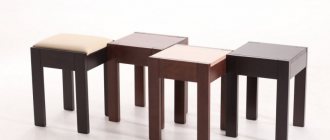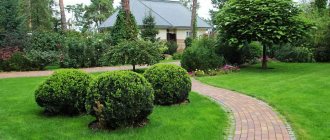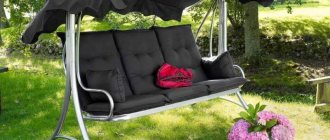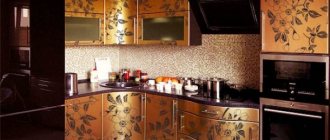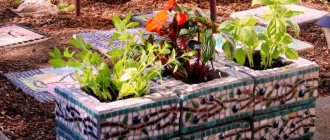In simple words about the landscape
Design is a whole science, but it is not always possible to learn it at universities and other educational institutions.
The ability to see and create beauty should be in the blood, and come not from a diploma with honors, but from the heart.
It is not at all necessary to study for years to become a designer; you can create landscape objects with your own hands, which is what today’s article is devoted to.
Don't be afraid to be creative and create something new, because many inventions were recognized long after they were created.
True beauty is always deeper, follow the call of your soul, and it will lead you where you should.
Do-it-yourself landscape design of a summer cottage
You can create a spectacular and stylistically correct landscape design for your summer cottage with your own hands. The main thing is to know the algorithm and follow it exactly. Thoughtful vegetable beds will allow you to feast on delicious vegetables or herbs and enjoy the picturesque design of the site.
Site layout
The first integral stage of developing a vegetable garden in landscape design is planning the project, namely: the place where everything will be located. It is advisable to first think about the placement of zones, and then draw a plan on paper. This approach to business will guarantee that even on several hundred square meters it will be possible to plant healthy vegetables, tasty berries and beautiful flowers.
Important! To separate zones, you can use visual methods, for example, a play of colors (make the area with flowers bright, with vegetables - exclusively green), use lighting sources (beautiful lanterns or, conversely, spotlights on the ground) or give preference to more practical elements. The latter include low fences, paths and even full-fledged partitions.
Moreover, experts do not recommend mixing a vegetable garden and a garden. In an ideal execution, the picture looks like this when separate places were allocated for these territories. One of the possible options: beds - on the sunny side, flowers - where it is convenient to enjoy their beauty, trees - under the windows to create shade or in the corner of the yard. Pay attention to selecting the size of the garden. There is absolutely no need to make it big. A small one is enough, where the most important or tasty crops for the owner will grow.
How to choose a garden style
For maximum aesthetics of the house and garden area, it is worth deciding on the desired style in which the entire area will be decorated. When the choice is made, you need to adhere to the rules and recommendations so that the site really pleases with its aesthetics and harmony.
Read more about the rules and features of the Dutch style of landscape design.
Popular destinations:
- Oriental. It is called the most unusual. The main elements are pebbles and crushed stone used for decoration. The stone is selected according to color and size for overall harmony. It is acceptable to use any other cobblestones. An interesting addition is a small pond. It is important that the water in it does not stream and disturb the soil, so attention should be paid to a good drainage system. Among the obligatory plants: bamboo (you can even make a low fence from it), boxwood.
- Rustic. It is also called country and rural. The main advantages are simplicity and rustic comfort. The direction is natural and simple. Characteristic features: simple plants, the use of old utensils and even unnecessary things for decoration. The materials used are stone, wood and wicker, used both to create furniture and fences.
- Modern. This is an interesting movement that includes several styles, including modernism, cubism, and minimalism. Concrete or stone slabs are suitable for paths, terraces and fences. The flower beds must be at the same level with each other; their preferred shape is a square or circle. The main task of this style is thoughtfulness of details and clear geometry.
- Regular. It is also called geometric. This is an interesting direction where strict lines and strict adherence to stylistic standards are important. Lawns and beds should be level, flower beds and other garden elements should be arranged symmetrically. It is acceptable to introduce a fountain or statue into the landscape design.
- Alpine. Here the emphasis is on the decorative side. Most often, preference is given to wild plants, which are placed in multi-level flower beds and supplemented with pebbles and stones. Garden crops are also planted using this technology, which looks impressive and unusual.
- Landscape. This is the most calm and natural direction for garden conditions. In addition to garden crops, spruce and coniferous shrubs are used. It is permissible to construct an artificial reservoir, for example, a pond or even a stream.
There are other styles for decorating a garden plot: Mediterranean, English, French and even exotic. You can always give them preference if you want to add a touch of originality or sophistication to the design of your garden, home and garden area.
Did you know? Green manure plants (for example, phacelia) have a beneficial effect on the physical properties of the soil. They are able to improve its structure and increase fertility, as well as attract pollinating insects to cultivated plants.
Blueprints
Remember that even the smallest vegetable garden requires careful planning. When the first sketch is made and the style is selected, it’s time to start developing drawings for the site. For these purposes, you can contact a specialist, use a special program, or make an approximate version by hand. Be sure to consider the dimensions.
A previously drawn garden on paper will allow you to analyze the site and make adjustments if necessary. Experts recommend waiting a year (until the next planting) to implement the plan, considering, in particular, the placement of new beds to make a final decision and understand whether the implemented idea suits you. Life and comfort requirements can make their own adjustments. You may have to modify something and abandon something. And only then can we proceed to full-scale action. However, if you are completely sure, the “grinding in” step can be omitted.
How to make beds
Organizing comfortable beds is very important. The process is completely individual for each person: some are comfortable with a clear structure and identical areas with planted plants, while others prefer a more chaotic arrangement. In any case, a responsible approach to organizing beds will allow you to plan your own plantings. Experts recommend taking a closer look at clear geometric contours. This will allow you to achieve maximum convenience and visual accents in landscape design. And also the site will always have a feeling of order and cleanliness.
Important! High beds are mainly used to place greens and crops that require considerable effort to care for. And this procedure will be facilitated due to the fact that the flowerbed is raised, which means that the energy will be spent with maximum efficiency.
To solve the problem of non-ideal (i.e., unsuitable for easy growing, for example, acidic, clay, with impurities, etc.) soil, you should pay attention to high beds. This method will allow not only to monitor the organic and mineral components of the soil, but also to allow crops to feel comfortable, and for people to count on a good harvest and achieve originality in the design of their garden. Of course, such an approach requires investment in both time and effort, but all this will be returned in full, and most importantly, your back will not hurt after weeding.
It is worth listening to these recommendations:
- you should not make the beds too wide - there should be good access to them;
- you need to try different design options in practice to understand what is more convenient in each specific case;
- You can make beds of any length, the main thing is the ability to freely reach the middle from the path.
It is very important to think about how to divide the area allocated for a vegetable garden into beds. It might be worth choosing paths as a divider, or maybe wicker fences or hedges would be a more comfortable option. It is absolutely not necessary to give preference to the “grandmother’s” method and make the beds in rows. You can plant plants in a wheel, a cart, or even in vertical posts to create an aesthetically pleasing landscape and ensure ease of care. It all depends on your imagination and your own preferences for comfort.
Important! The ideal raised bed is up to 90 cm wide and up to 100 cm high. This guarantees ease of plant care.
Interesting bed ideas:
- From ordinary boards, timber, slabs (side parts of logs) or old lining. The main thing is to pay attention to durability. The wood is impregnated with special preparations that protect the material from rot. An alternative treatment option is to use copper sulfate. The technology is used for fencing beds.
- With decorative edges. They are used to raise beds above the soil for ease of care and decoration of the site. As a fence, you can use glass or plastic, wicker parts made of wicker, slate, etc. Markings and grooves are first made, and then the selected materials are driven in in accordance with the selected geometric figure. The fenced area is covered with earth, and the beds become higher.
- High beds by organizing them at a height of 1–1.5 m above the ground in any convenient way: by embankment or using suitable structures. They look original and impress with their reliability. Maintenance will be as simple as possible. The secret of the design is protection from pests and weeds, and the edges of the beds will not be washed out. Any material can be used, but it is important that it is durable and strong. Brickwork or concrete blocks are good choices, but wood can also be used.
- In flowerpots or containers. This can easily become the main accent or original feature of the site. Containers made of wood or plastic are suitable. It is advisable to use mobile and compact options. You can use barrels, basins and even used clay pots. But it is better to avoid using car tires, as they emit toxic substances.
- Multi-tiered options. Their creation will take a lot of time, but it will turn out very original. In principle, you can purchase ready-made models in specialized stores, but making them yourself will allow you to be proud of your creation and save money. In such a bed, root vegetables or zucchini are planted on the lower tier, the middle one is used for greens, peppers, tomatoes or eggplants, and the top one is used for climbing crops such as beans or cucumbers. At the end of the harvest, flowers can be planted.
- Exclusive beds. This could be an old boat or even a bathtub filled with soil. You can make table beds that your guests will definitely be delighted with. Any geometric compositions will also look extraordinary.
Small architectural ideas
To clarify the meaning of the phrase, we will give examples of what elements can relate to small architectural forms that are somehow involved in the landscape design of the yard.
- Gazebos, verandas and the like;
- Arches, trellises;
- Sculptures, fountains, fences;
- Ponds, reservoirs, bridges;
- Any other decorative elements present in the landscape design.
Every person can encounter small architectural forms dozens of times a day, because they include bus stops, benches, telephone booths and much more.
Garden of Cosmic Reflections
Location: Scotland.
Charles Jencks' Garden of Cosmic Thoughts was inspired by fractals and black holes and attempted to combine science, mathematics, sculpture and landscaping. The garden is unique. There is no plant wealth here, but there are mathematical formulas and scientific phenomena reflected in conditions that skillfully combine natural features, artificial symmetry and curves.
10
We improve the recreation area
You can read a book, retire in silence, receive guests and much more in a specially designated area. A gazebo, terrace or even a pergola will come in handy for this. They all perform the same task and are located closer to home.
If a gazebo is installed and one of its sides is heavily ventilated, then it is better to make one wall blank, or, as an option, plant climbing plants.
Recommendations from experts
Excessiveness is not welcome anywhere, that’s a fact. Accordingly, when the question of arranging the landscape design of a house is raised, there is no room for error.
To avoid possible mistakes, you should take into account a number of tips from those who have already eaten more than a pound of salt on this.
Regardless of what zones the territory is divided into, everything should be harmoniously combined in a single stylistic solution. The same applies to paths/fences and other elements.
If the area is small, do not miss the chance to use methods to visually expand the space.
Multi-level flowerpots with flowers will add charm to the interior and save space.
If the site is located on a slope, this is a great chance to take advantage of this by creating an alpine slide and many other design solutions that highlight the uniqueness of the area.
If the land allows your imagination to run wild, you can install fountains or large flower arrangements.
As for fountains, you can make them with your own hands, which is facilitated by a huge number of master classes on the Internet. Of course, the alternative would be to go to the store, but this could put a strain on the family budget.
There is no need to rush into making a choice; it is advisable to look at more than one photo of landscape design in order to accurately decide on your option.
Assess the capabilities of the land plot, the financial side of the issue, and, of course, the time to put the plan into action.
Today there are many programs that allow you to recreate a virtual version of the future landscape and add/remove decorative elements.
Minimum effort and maximum result, that’s what following the recommendations will lead to.
Turning to specialized specialists will provide an opportunity to avoid such headaches, but will affect the budget. However, here you need to find an individual solution.
Creating lazy beds
The creation of such beds allows you to reduce weeding, increase productivity, and such beds will also allow you to increase the time for rest.
To create such beds, you need to make a box or rectangle from boards tightly packed together. Instead of wood, you can use building materials such as slate, sheets of metal and even permanent beds made of brick.
The size of such beds can be almost any, the main thing is that the plants in such beds are not crowded and they should be positioned so that they receive maximum sunlight during the day.
From the inside of the knocked together frame, scraps of PVC pipes are attached, in the corners of the structure, as well as in several places along the long side of such ridges. The ends of such pipes should protrude slightly beyond the top edge of the boards. Subsequently, these trimmings will serve to insert arches onto which the covering material will be stretched, if necessary.
The boxes are installed on the site in a pre-selected place; it is recommended to lay a fine-mesh metal mesh on the bottom of such beds, which in some cases can protect the plantings from rodents. Soil is poured inside such beds of boxes and after filling the boxes, plants are planted.
In the summer, such beds need to be watered almost every day in the morning or evening, especially in the heat. To facilitate this task, you can always install drip irrigation systems, which will allow you to water the plants not very often, but quite abundantly. This type of garden watering is easy to do with your own hands.
To plant plants, such beds are dug up in the spring, seeds or seedlings are planted, and then the soil is covered with mulch to eliminate weeds.
Read here Do-it-yourself windmill - the best ideas and instructions for building decorative windmills in the garden and on the site (105 photos)
Such beds quickly pay for themselves and when growing cultivated plants, such beds can produce a good harvest.
Creativity in action
To furnish a country house, it is not at all necessary to use exclusively expensive building materials, although in some cases they will be very appropriate.
The simplest elements, such as a homemade gazebo or a wicker fence, will add charm to the design of your site.
Actually, the latter’s technique is very useful when creating small fences for a flower garden, or other solutions.
Plaster sculptures, fakes made from plastic bottles, creating an artificial pond and other ideas can once again emphasize the uniqueness of the house and reveal the creative nature of the home owners.

